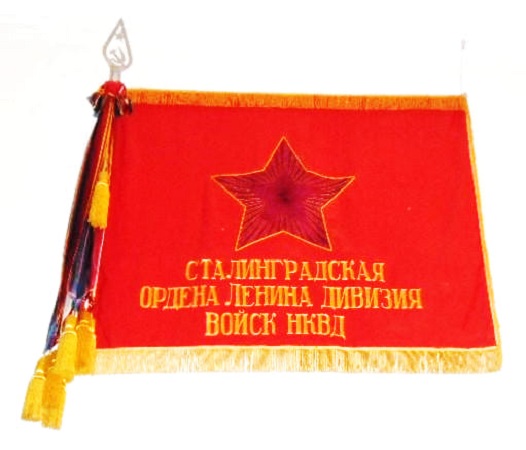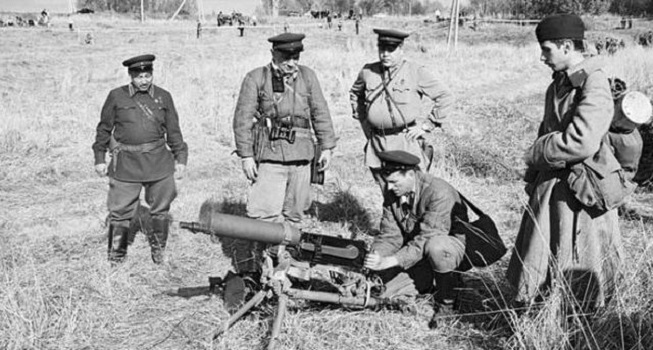● ● ●
During World War II the People's
Commissariat for Internal Affairs—Narodnyy Komissariat
Vnutrennikh Del or
NKVD—exercised total police power in the USSR. It
controlled the ordinary police, the secret political police,
the Border Guard, the Gulag (punitive labor camp)
organization and the regular prison system. The Internal
Troops of the NKVD, nicknamed the Bluecaps, were responsible
for the security of public infrastructure such as railroads,
industrial installations, power stations, dams, etc.,
besides maintaining mobile units that could be deployed to
break strikes and suppress unrest. In Moscow, the NKVD’s
Kremlin Garrison provided security for the nerve center of
the Soviet government. All in all, therefore, the organs of
state security had a marked paramilitary character.
When war broke out on 22 June 1941
the NKVD’s Main Directorate for Mobile Troops mobilized a
number of motorized rifle divisions in addition to its
already existing Special Purpose Motorized Rifle Division.
These mobile units were intended to supplement the static
NKVD guard units and preserve internal order. But in the
desperate conditions of the war’s early months many NKVD
units had to be committed to combat, fighting as regular
soldiers. Additional NKVD rifle divisions were hastily
organized, using whatever troops lay to hand, and dispatched
to the front.
The 22nd NKVD Motorized Rifle
Division was typical. The division was activated in Riga on
23 June 1941. According to the prewar mobilization plan it
was to absorb three regiments of the NKVD Internal Troops
and to receive various support units from the Red Army. But
two of the regiments were unable to join the division and so
it was filled out by the 83rd Railroad Protection Regiment,
the 155th Escort Battalion and a Red Guards militia
battalion. The escort battalion had previously been
responsible for transporting prisoners to NKVD camps and
prisons; the militia battalion was raised with workers from
the factories in Riga. The division received no artillery,
antitank or logistical support units. It was assigned to the
10th Rifle Corps of Eighth Army and was effectively wiped
out in the subsequent fighting. The division was disbanded
in late August of 1941 and its remnants were reassigned.
Other NKVD divisions were
eventually transferred to the Red Army. The 13th NKVD
Motorized Rifle Division was set up at Voronezh in May 1942.
It participated in the fighting on the southern sector of
the front, suffering heavy casualties in the defense of the
Don River line. In late June the division was withdrawn from
the front and sent to Tula for reorganization. In August it
was transferred to the Red Army as the 95th Rifle Division
and as such participated in the defense of Stalingrad. In
March 1943, in recognition of heroic conduct in the defense
of Stalingrad, it was redesignated as the 75th Guards Rifle
Division.

Color of the 10th NKVD
Rifle Division, which fought in the Battle of Stalingrad
But the NKVD’s primary military
mission was not to fight, but to make sure that others
fought. Even before the war, a special motorized NKVD
regiment was attached to every field army in the five
western military districts. These regiments embodied a
variable number of “blocking detachments,” usually of
battalion strength, whose basic task was to stop
unauthorized retreats—if necessary by firing on the
retreating soldiers. They were also empowered to detain
stragglers and deserters, control traffic, process prisoners
of war and generally maintain order in the Army’s rear
areas, serving in effect as the Red Army military police
corps. At first the blocking detachments were made up of
ordinary soldiers under NKVD officers, but sometimes they
proved reluctant to fire on their own comrades, so
eventually the job was handled exclusively by NKVD troops.
The blocking detachments were armed and equipped as
motorized infantry, sometimes including light tank and
armored car companies.
A November 1941 report to NKVD
chief L.P. Beria detailed the work of the blocking
detachments: A precise total of 657,364 Red Army personnel
had so far been arrested on suspicion of desertion, and most
were immediately sent back to the front. However, 25,878
were detained and variously charged with cowardice, treason,
sabotage, espionage, instigating panic among the troops,
self-inflicted wounds, etc. More than 10,000 of these men
were executed, a third of them publicly, and the rest were
consigned to penal battalions. Every field army maintained
such battalions and they were committed to battle in the
most dangerous situations, with the expectation most of
their personnel would be killed.

Troops of an NKVD blocking
detachment (World War Photos)
The NKVD blocking detachments did
not always have an easy time of it. On more than a few
occasions they had to fight pitched battles with retreating
Red Army units that refused to turn back to be annihilated
by the Germans. In this manner Stalin’s ringing slogan—“Not
one step back!”—was brutally enforced. Only in 1944, after
the war situation had turned decisively in the USSR’s favor,
were the blocking detachments scaled back.
Sometime in 1942—the details are
murky—the SMERSH organization was created within the NKVD;
the name is an acronym based on the Russian for “Death to
Spies.” SMERSH was broadly responsible for counter-espionage
and counterintelligence and one of its departments delt with
Red Army affairs. Its duties included securing the front
line against penetration by enemy agents and “anti-Soviet
elements,” investigating treasonous activities in the ranks,
preventing desertion and evasion of duty, and processing
military and civil personnel freed from enemy captivity.
These latter groups were viewed by the regime with the
darkest suspicion as potential subversives, and many such
people were summarily dispatched to the Gulag. SMERSH was
headed by Viktor Abakumov, who was to become Minister of
State Security after the war.
By all accounts SMERSH was highly
effective as a counter-espionage and counterintelligence
organization. But its supervision of the Red Army was
carried out in a manner that reflected Stalin’s own paranoia
and cruelty. Among the countless victims of SMERSH was one
Captain of Artillery Aleksandr Isayevich Solzhenitsyn,
arrested in East Prussia in February 1945 and consigned to
the Gulag on grounds of disseminating “anti-Soviet
propaganda”: critical comments in a private letter to a
friend about atrocities committed by Red Army troops against
German civilians. (Solzhenitsyn was later to take a grand
literary revenge on his oppressors.)
Given the nature of the Stalin
regime, the NKVD played a key role in the Soviet war effort.
Patriotic commitment did indeed motivate the Red Army—but it
was powerfully reinforced by a systemic reign of terror
perpetrated by the organs of state security.
● ● ●